Overview
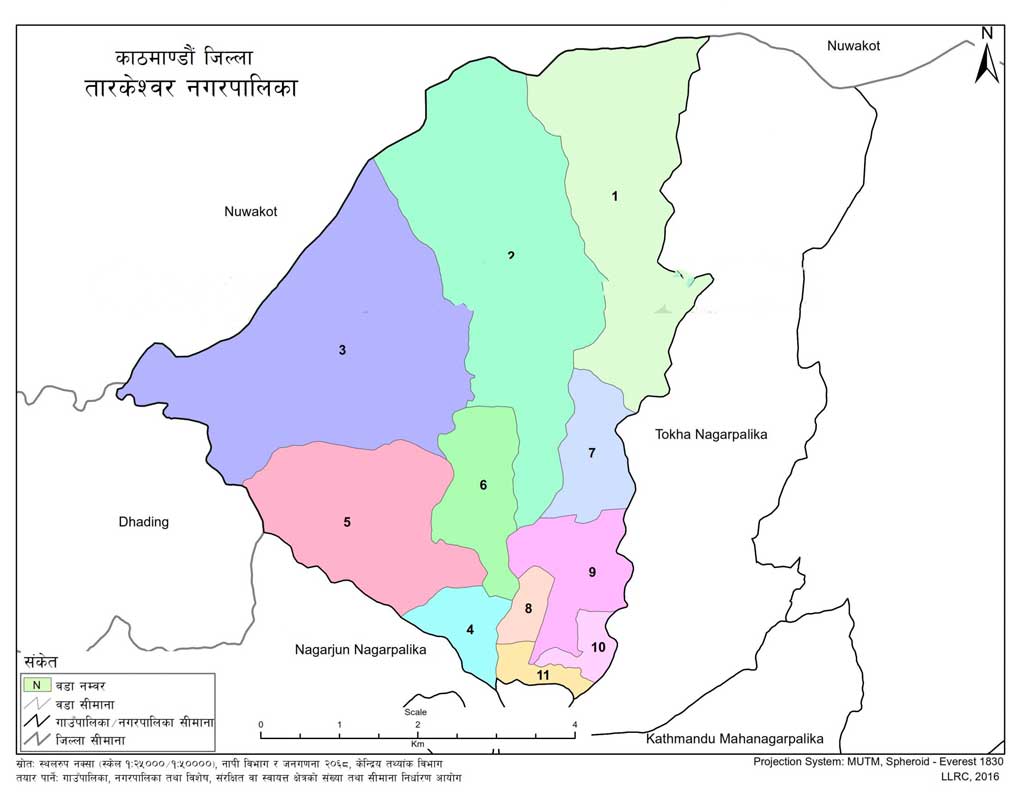
This picturesque town is surrounded by the Nuwakot district in the North and Western-North; Dhading district in the remaining West and South; Nagarjun Municipality and Kathmandu Metropolitan are also located in the South while sharing its geographical boundary with Tokha Municipality in the East thereby creating a tapestry of diverse landscapes.
The municipality was formed by the merger of several former Village Development Committees including Dharmasthali, Futung, Goldhunga, Jitpurphedi, Kavresthali, Manamaiju, and Sangla. In 2021, Tarakeshwor boasted a population of 151,479, showcasing its significance as a thriving community.
Tarakeshwor is not only rich in population but also in attractions. The Shivapuri Nagarjuna National Park, Tarakeshwor Temple, Bhuvaneshwori Temple, Shanti Dham Temple, Mahadeva Mandir, Jayantipur Temple, Manamaiju Temple and recreational spots like Jhanda Park and View Tower, Kunchipakhal are some of the prominent landmarks that grace the region. The municipality is adorned with the beauty of famous rivers such as Bishnumati Khola, Mahadev Khola, Seshmati Khola, and Sangle Khola. The Bishnumati River, in particular, gracefully divides Tarakeshwor and Tokha, creating a natural boundary.
Tarakeshwor is a magnet for tourists, boasting an array of captivating attractions that makes it a must-visit destination. Tourism flourishes in specific wards of Tarakeshwor with Ward No. 1, 2, and 3 being popular destinations housing attractions like Bhubaneshwori Temple, Shanti Dham, way to Jhor Waterfall, Jhanda Park, Tarakeshwor Mahadev Temple and many others. On the other hand, Wards No. 7, 8, 9, and 10 are recognized as industrial and business areas, contributing to the municipality’s economic development.
Tarakeshwor Municipality - Salient Features
Tarakeshwor municipality is recognized for its unity in diversity. The municipality is prosperous with various salient features with some of them as under:
Geographical Overview
Encompassing an area of 34.9489 square kilometer (sq.km.) of area, Tarakeshwor boasts a population density of 4,334 per square kilometer of area, making it a vibrant and closely-knit community. Tarakeshwor Municipality unfolds its beauty against the backdrop of Shivapuri Nagarjuna National Park (Formally, at the inception, Shivapuri Nagarjuna National Park was recognized as Shivapuri National Park, initially covering 144 sq.km. Later it was extended with Nagarjuna Forest Reserve covering 15 sq.km in 2009, hence collectively known as Shivapuri Nagarjuna National Park thereafter). As of the latest census in Bikram Samvat 2078 (Nepal Census 2021), the municipality sprawls across an area that encompasses a diverse range of geographical features. From the steep slopes of Shivapuri hill in the north to the Bishnumati River in the south, the region displays a varied topography that includes terraced fields, plateaus, and bhanjyangs.
Gender Distribution and Age Structure
The annual population change, standing at 6.00% from 2011 to 2021, indicates sustained development and demographic dynamism. The municipality exhibits a nearly equal gender distribution, with 49.70% males and 50.30% females.
Population by Ward | ||||||
Ward No. | Number | Percentage of Population | ||||
Male | Female | Total | Male | Female | Total | |
1 | 3,422 | 3,350 | 6,772 | 2.26% | 2.21% | 4.47% |
2 | 6,487 | 6,667 | 13,154 | 4.28% | 4.40% | 8.68% |
3 | 3,563 | 3,383 | 6,946 | 2.35% | 2.23% | 4.59% |
4 | 9,093 | 9,231 | 18,324 | 6.00% | 6.09% | 12.10% |
5 | 8,889 | 8,843 | 17,732 | 5.87% | 5.84% | 11.71% |
6 | 6,732 | 6,896 | 13,628 | 4.44% | 4.55% | 9.00% |
7 | 6,306 | 6,515 | 12,821 | 4.16% | 4.30% | 8.46% |
8 | 8,685 | 8,888 | 17,573 | 5.73% | 5.87% | 11.60% |
9 | 8,536 | 8,459 | 16,995 | 5.64% | 5.58% | 11.22% |
10 | 7,103 | 7,229 | 14,332 | 4.69% | 4.77% | 9.46% |
11 | 6,465 | 6,737 | 13,202 | 4.27% | 4.45% | 8.72% |
Total | 75,281 | 76,198 | 151,479 | 49.70% | 50.30% | 100.00% |
Source: Nepal Census 2021 | ||||||
The age structure is characterized by 22.45% of the population in the 14 age and below group, 73.48% in the 15-64 age group, and 4.07% in the age group of 65 and above. This diverse age composition contributes to the community’s vitality.
Population by Age Group (Broad Classification) | ||||||
Age Group | Number | Percentage of Population | ||||
Male | Female | Total | Male | Female | Total | |
Above 64 | 2,830 | 3,337 | 6,167 | 1.87% | 2.20% | 4.07% |
15-64 | 54,009 | 57,291 | 111,300 | 35.65% | 37.82% | 73.48% |
Below 15 | 18,442 | 15,570 | 34,012 | 12.17% | 10.28% | 22.45% |
Total | 75,281 | 76,198 | 151,479 | 49.70% | 50.30% | 100.00% |
Source: Nepal Census 2021 | ||||||
It can be observed that majority of the population with 111,300 in number belongs to the working age group (15-64) thereby creating this municipality with a tremendous productive potential. This age group can contribute at the huge level in the development of national economy and maintaining national prosperity.
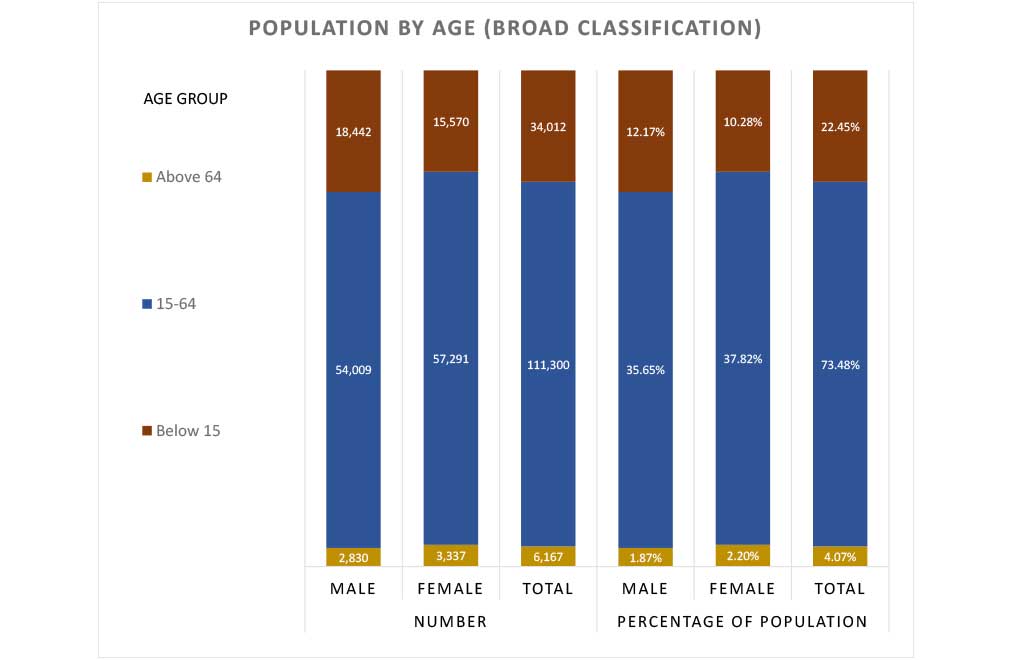
As the current mayor of Tarakeshwor municipality also belongs to this age group, he is always keen and admired towards the youths in the development works.
Population by Age Group (Condensed Classification) | ||||||
Age Group | Number | Percentage of Population | ||||
Male | Female | Total | Male | Female | Total | |
Above 95 | 16 | 40 | 56 | 0.01% | 0.03% | 0.04% |
90-94 | 62 | 62 | 124 | 0.04% | 0.04% | 0.08% |
85-89 | 152 | 195 | 347 | 0.10% | 0.13% | 0.23% |
80-84 | 281 | 304 | 585 | 0.19% | 0.20% | 0.39% |
75-79 | 475 | 659 | 1,134 | 0.31% | 0.44% | 0.75% |
70-74 | 748 | 878 | 1,626 | 0.49% | 0.58% | 1.07% |
65-69 | 1,096 | 1,199 | 2,295 | 0.72% | 0.79% | 1.52% |
60-64 | 1,638 | 1,694 | 3,332 | 1.08% | 1.12% | 2.20% |
55-59 | 2,209 | 2,081 | 4,290 | 1.46% | 1.37% | 2.83% |
50-54 | 3,564 | 3,262 | 6,826 | 2.35% | 2.15% | 4.51% |
45-49 | 3,949 | 3,645 | 7,594 | 2.61% | 2.41% | 5.01% |
40-44 | 5,462 | 5,362 | 10,824 | 3.61% | 3.54% | 7.15% |
35-39 | 6,373 | 7,061 | 13,434 | 4.21% | 4.66% | 8.87% |
30-34 | 7,064 | 8,527 | 15,591 | 4.66% | 5.63% | 10.29% |
25-29 | 7,756 | 9,223 | 16,979 | 5.12% | 6.09% | 11.21% |
20-24 | 8,270 | 9,367 | 17,637 | 5.46% | 6.18% | 11.64% |
15-19 | 7,724 | 7,069 | 14,793 | 5.10% | 4.67% | 9.77% |
10-14 | 6,343 | 5,697 | 12,040 | 4.19% | 3.76% | 7.95% |
05-09 | 6,532 | 5,337 | 11,869 | 4.31% | 3.52% | 7.84% |
Below 5 | 5,567 | 4,536 | 10,103 | 3.68% | 2.99% | 6.67% |
Total | 75,281 | 76,198 | 151,479 | 49.70% | 50.30% | 100% |
Source: Nepal Census 2021 | ||||||
Religious Diversity
People with different religious beliefs can be observed in Tarakeshwor municipality. Nepal Census 2021 revealed a diverse religious landscape. Hinduism dominates at 81.10%, followed by Buddhism (14.54%) and Christians (3.17%). The Kirat community (0.61%) and Islam (0.38%) also contribute, with 0.20% following other traditions. This religious pluralism showcases Tarakeshwor’s rich cultural tapestry and historical openness to various beliefs. Despite of variation in religious aspects, harmony is maintained by the people as they worship humanity to be superior of all.
Population by Religion | ||
Types | Population | Percentage |
Hindu | 122,854 | 81.10% |
Buddhist | 22,020 | 14.54% |
Christians | 4,805 | 3.17% |
Kirat | 927 | 0.61% |
Islam | 573 | 0.38% |
Others | 300 | 0.20% |
Total | 151,479 | 100.00% |
Source: Nepal Census 2021 | ||
Lingual Diversity
As people from different caste and religion inhabits in Tarakeshwor, it is obvious that they have different mother tongue. Nevertheless, language is never a barrier for communication among the adorable people of Tarakeshwor as they express and share their speech, love and emotions through the national language of all Nepalese that being the great Nepali language. This fact can be evident from the results of Nepal Census 2021 where a majority of 72.99% of the population in Tarakeshwor choose Nepali language as not just the language of communication but also as their mother tongue.

The use of Nepali language has not hindered their traditional language either. People use their own language as well within their family members and belongings from their own caste, family and their groups and this has led to the protection of our Nepalese traditional languages. It can be observed that 11.60% of the population use Tamang language as their major language followed by other languages such as Newari (7.65%), Magar (2.26%), Gurung (1.92%), and Rai (0.73%) which represents diverse ethnic linguistic groups. Additionally, languages like Bhojpuri, Maithili, and Ghale also contribute to the linguistic collage, emphasizing the cultural diversity within the region. This data underscores the importance of recognizing and accommodating various languages to foster inclusivity in community policies and initiatives. It can also be observed that people of one caste can easily understand and speak other caste language such as a Brahmin or Chhetri can be found speaking Newari or Tamang language besides Nepali language. It is due to the mutual respect and admiration shown within each other.
Population by Language | ||
Types | Population | Percentage |
Nepali | 110,566 | 72.99% |
Tamang | 16,901 | 11.16% |
Newari | 11,583 | 7.65% |
Magar | 3,429 | 2.26% |
Gurung | 2,903 | 1.92% |
Rai | 1,103 | 0.73% |
Bhojpuri | 936 | 0.62% |
Maithili | 611 | 0.40% |
Ghale | 582 | 0.38% |
Others | 2,865 | 1.89% |
Total | 151,479 | 100.00% |
Source: Nepal Census 2021 | ||
Land Diversity
Tarakeshwor’s landscape is a patchwork quilt of different types of lands. The plains of Samathar split and Tars offer a muddy texture, ideal for robust agricultural practices. In contrast, the red, loose, and sandy soils characterize the steep lands. The land’s fertility and moisture content vary, with the riverbanks proving to be more fertile and conducive to agriculture.
Catchment Areas and Water Bodies
Shivapuri Nagarjuna National Park emerges as a vital catchment area for Tarakeshwor. Small rivers, streams, and rivulets meander through the municipality, providing a lifeline for drinking water and irrigation.
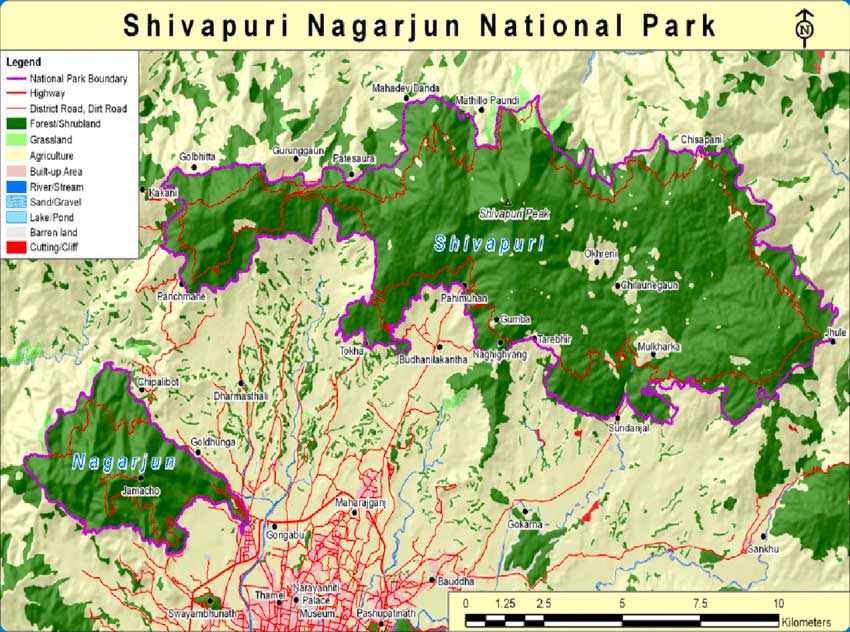
The trees in the northern part of the municipality are the reasons for being sources of drinking water for the people of Tarakeshwor. Prominent rivers include the Sangle, Mahadev, Ghate, Seshmati, Rudramati, Nagin etc. The city’s dependence on these water bodies underscores their significance in sustaining life within the region.
Climatic Zones
Tarakeshwor’s climate, influenced by its varied topography, can be categorized into three main zones. Areas like Sangla, Kavresthali, and Manamaiju experience a relatively hotter climate during the rainy season, earning them the designation of hot air zones. Futung, Dharmasthali, Jitpurphedi, and Goldhunga fall under the temperate climate category, marked by milder temperatures and less rainfall. The coldest zones, including Goldhunga, Phulbari, Chhaveli, Nyankandol, and Vaikhu, experience colder temperatures, enhanced by brisk winds.
Rich Flora and Fauna
Blessed with the embrace of Shivapuri Nagarjuna National Park, Tarakeshwor stands as a sanctuary for diverse flora and fauna. The park’s central zone, spanning across Ward No. 1, 2, 3, 4, and 5, contributes significantly to the city’s forest resources. The region is adorned with various types of forests, including private, community, and government-owned. The community forests, such as Salkot, Thanagadhi, and Simal Pakha, not only serve as a source of resources for the locals but also contribute to environmental conservation.
Climate and Agriculture
The diverse climates within Tarakeshwor influence the agricultural practices in the region. The fertile lands along riverbanks, coupled with the availability of grass, sugarcane, and apples, create an ideal environment for agriculture and animal husbandry. Farmers in the municipality engage in the cultivation of crops like corn, wheat, millet, and rice, contributing to the economic prosperity of the area.
Mineral Resources
Tarakeshwor isn’t just abundant in natural beauty but also boasts various mineral resources. The earth’s crust in this municipality harbors minerals such as coal, sand, and stone. Further studies have even identified the presence of elements like potassium, uranium, and thorium in select areas, hinting at the geological richness of the region.
Cultural Harmony in Tarakeshwor: A Melting Pot of Joyful Coexistence
Tarakeshwor Municipality: A Cultural Blend
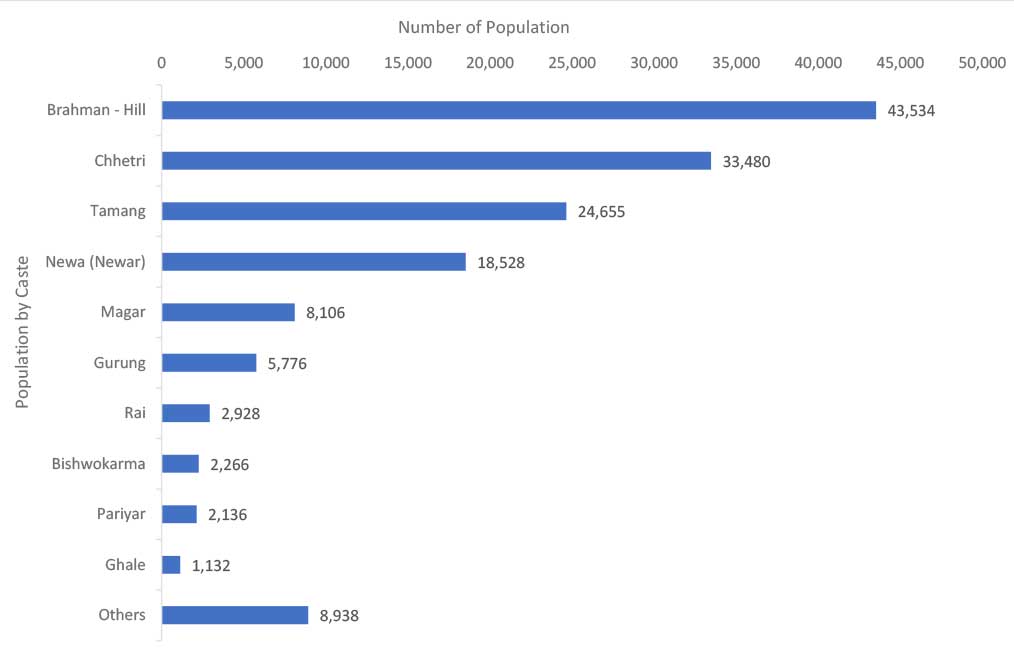
Nestled in the hills of Kathmandu, Tarakeshwor is like a colorful canvas painted with diverse cultures. Different communities live together here, making it a happy and vibrant place. Imagine this place as a big family with various members. According to the numbers, most of the family members are Brahmin (or Brahman) – Hill and Chhetri, making up more than half (50.84%). This unique blend fosters a rich cultural tapestry that adds to the charm of this picturesque municipality.
|
Population by Caste |
||||
|
Types |
Population |
Percentage |
||
|
Brahman – Hill |
43,534 |
28.74% |
||
|
Chhetri |
33,480 |
22.10% |
||
|
Tamang |
24,655 |
16.28% |
||
|
Newa (Newar) |
18,528 |
12.23% |
||
|
Magar |
8,106 |
5.35% |
||
|
Gurung |
5,776 |
3.81% |
||
|
Rai |
2,928 |
1.93% |
||
|
Bishwokarma |
2,266 |
1.50% |
||
|
Pariyar |
2,136 |
1.41% |
||
|
Ghale |
1,132 |
0.75% |
||
|
Others |
8,938 |
5.90% |
||
|
Total |
151,479 |
100.00% |
||
|
Source: Nepal Census 2021 |
||||
The caste distribution in Tarakeshwor, Nepal, as per the 2021 census, presents a diverse social landscape. Brahman – Hill constitutes the largest group at 28.74%, followed by Chhetri at 22.10%. Tamang and Newa (Newar) communities contribute significantly, comprising 16.28% and 12.23%, respectively. Magar, Gurung, and Rai represent distinct ethnic groups, while Bishwokarma, Pariyar, and Ghale contribute to the diverse community composition. The inclusion of various other castes, totaling 5.90%, emphasizes the heterogeneous nature of Tarakeshwor’s population. This data underscores the importance of recognizing and respecting the varied caste identities, promoting social harmony and inclusive policies within the community.
Harmony in Tamang community
The Tamang community brings its unique flavors to this cultural mix. With more than 24,000 Tamang people, they play a big role in making Tarakeshwor lively and colorful. Their traditions and practices add a special touch to the community life.
Traditions of Brahmin and Chhetri Families
The Brahmin and Chhetri, who are the majority, have their own special ways of doing things. They follow traditions closely, like celebrating births, weddings, and saying goodbye to loved ones. It’s like a beautiful dance of customs passed down through generations.
Dewali: The Unique Festival of Kul puja Celebrated by Chhetri in Tarakeshwor
In the charming town of Tarakeshwor, the Chhetri community comes together to celebrate a distinctive festival known as Dewali. This festival, also referred to as “Kul Puja,” holds immense cultural significance for the Chhetri families, who consider it the most important occasion on their calendar. Dewali revolves around the belief that appeasing their family God or Goddess through puja is essential for the well-being and prosperity of the entire community.
Dewali is an annual or biennial event where Chhetri families gather to perform intricate rituals aimed at pleasing their family deity. A central aspect of the celebration involves making offerings to the God or Goddess. Two prevalent forms of offerings include sacrificing a goat or presenting a coconut. The choice of offering varies from family to family, adding a diverse and dynamic element to the festival. In contemporary times, most families perform Kul Devta puja with offerings of fruits, flowers, incense, and other symbolic items. People express their devotion and seek blessings by performing aarti, chanting prayers, and offering food items to the deity.
One of the distinctive features of Dewali is the deep-seated belief that during specific rituals or ceremonies, the kul devta (family God) can enter a human body. This phenomenon is viewed as a divine presence or a direct form of communication with the deity. The devotees, during these moments, feel a profound connection with their family God, fostering a sense of spirituality and unity within the community.
Another intriguing aspect of Dewali is the worship of Shila, also known as Shaligram. Shaligram is a sacred stone used in Hindu rituals, believed to bring good luck, prosperity, and blessings to those who worship it. During the festival, devotees offer the blood of the sacrificed goat to the Shaligram, symbolizing a majestic connection between the earthly and the divine.
Dewali is more than a mere religious event; it is a celebration of cultural identity and shared beliefs among the Chhetri community. The festival strengthens familial bonds and fosters a sense of community spirit. It serves as a time for reflection, gratitude, and the reaffirmation of faith, marking the continuity of cultural traditions across generations. It is believed that through these rituals, the kul devta becomes a protector of the community, ensuring the well-being of the people.
The Chhetri community celebrates Dewali during specific times, either on Mangsir Shukla Purnima or the following Panchami, or Jestha Sukhla Purnima or its subsequent Panchami. During these moments, families unite to perform rituals, offering sacrifices to their family God. It is believed that these ceremonies, conducted at specific times, fortify the kul devta’s protection over the community, ensuring the well-being of the people.
In summary, a celebration of ancestry, and a way of passing down customs and rituals from one generation to the next. It provides a spiritual anchor, reminding individuals of their cultural heritage and offering a source of solace, prosperity, and collective identity for those who engage in its heartfelt observance. Dewali stands as a cherished tradition among the Chhetri community in Tarakeshwor, observed either on Mangsir Shukla Purnima or the following Panchami, as well as Jestha Sukhla Purnima and its subsequent Panchami. This festival, marked by rituals and offerings, symbolizes the strong bond between families and their family God. The belief in the protective presence of the kul devta during these ceremonies adds a profound spiritual dimension to the community’s unity. Dewali not only serves as a cultural anchor but also reinforces a sense of communal security, ensuring the well-being of the people in Tarakeshwor.
Newari Community: Keepers of Traditions
Now, there’s another group called the Newari community, numbering around 18,000. They bring in their own language, script, and customs. What’s cool is that they practice both Hindu and Buddhist traditions. This mix of cultures adds extra flavor to the cultural potluck.
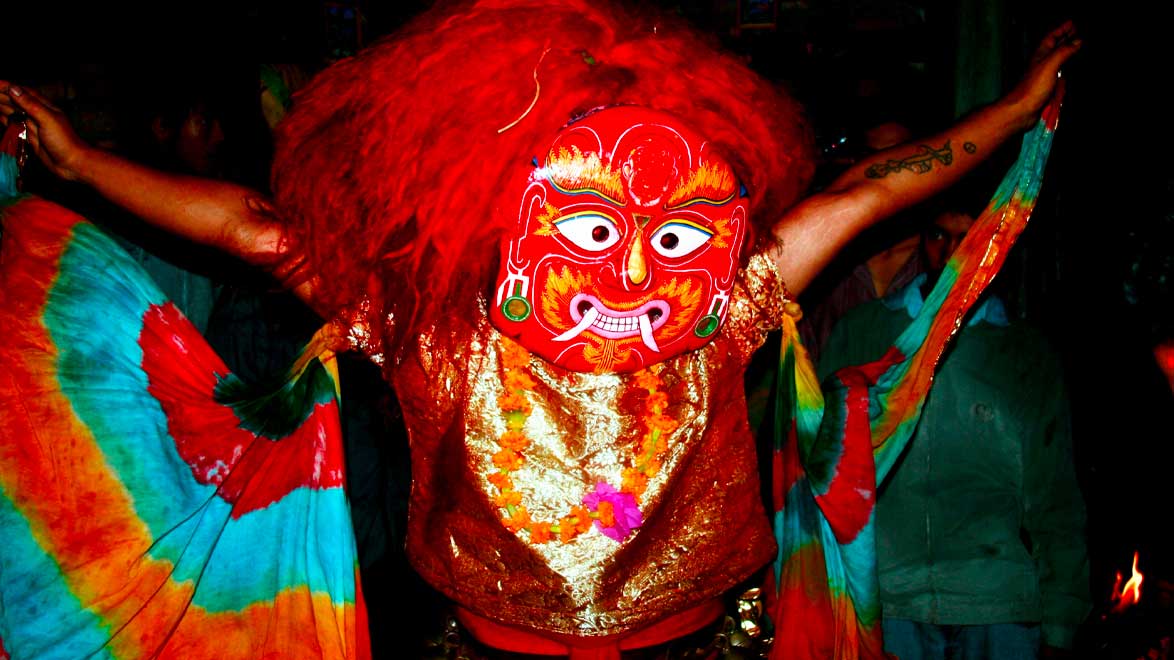
Cultural Celebrations
Life in Tarakeshwor is like a constant celebration. Different communities have their own special celebrations, like the Bhoto Jatra of Manamaiju and the Phulpati tradition from the Malla period. Each celebration is a burst of colors and joy.
Living Together Happily
Despite being different, everyone in Tarakeshwor lives together happily. It’s like a big happy family where everyone has their own role. The community is like a rainbow, with each color making the whole picture beautiful.
In Tarakeshwor, the mix of cultures is not just a thing – it’s the heart of the place. Different communities, each with its own traditions, live side by side, creating a beautiful and lively cultural blend. It’s a reminder that in this small corner of the world, unity and happiness come in many shades.
Tarakeshwor: A Harmonious Blend of Nature, Spirituality, and Culture - An Ideal Tourism Destination
Hiking in Tarakeshwor
Tarakeshwor Hiking, starting from Tinpiple near Kathmandu, is a perfect short getaway within the Shivapuri Nagarjun National Park. The moderate trek offers stunning views of hills and, on clear days, the Himalayan range. The trail may lead to the Tarakeshwor Temple, adding a cultural touch. With its proximity to Kathmandu, the hike is accessible and takes a few hours to half a day. Check local regulations and weather conditions before heading out for this refreshing and scenic experience.
Bhubaneshwori Temple
Bhubaneshwori temple is located in the vicinity of Tarakeshwor, Kathmandu. Bhubaneshwori Temple is a religious site dedicated to the goddess Bhubaneshwori, and it holds cultural and spiritual significance for the locals. Pilgrims visit the temple to offer prayers and participate in religious ceremonies.
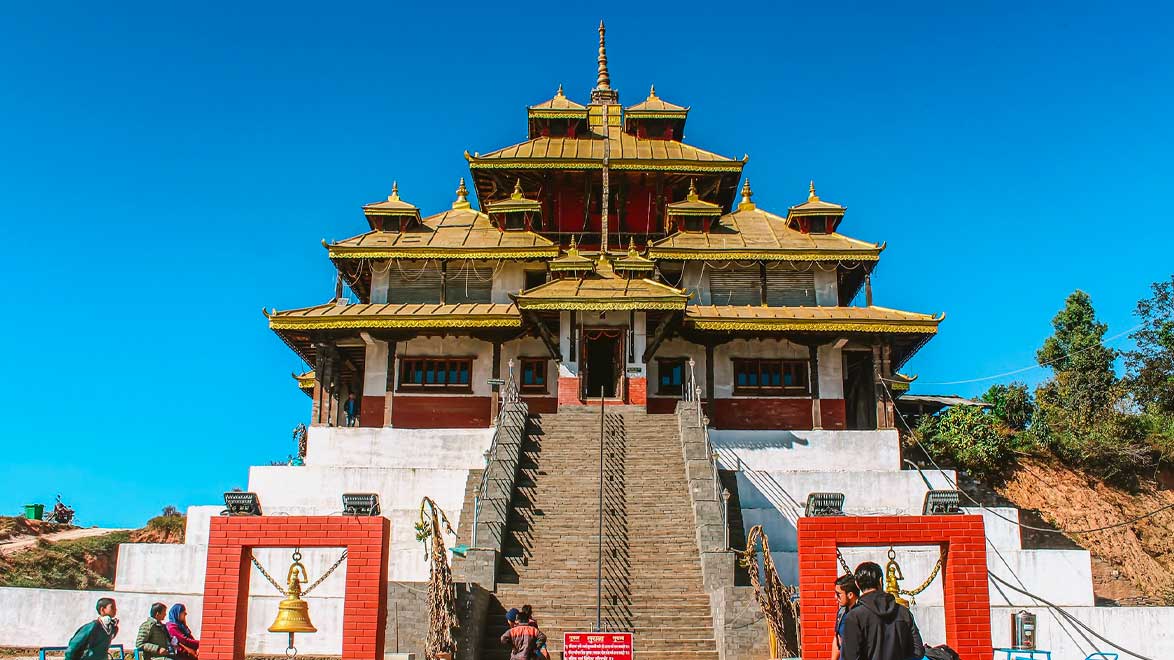
Tarakeshwor Mahadev Temple
Resting in the embrace of Tarakeshwor, the Tarakeshwor Mahadev Temple stands as a testament to devotion, dedicated to the Hindu deity Lord Shiva. Its architecture echoes with cultural importance, drawing devotees who seek blessings and participate in age-old religious rituals. Within its sacred precincts, the spiritual heartbeat of the region pulses, making it an honored place of worship.
Shanti Dham
In the peaceful area near Tarakeshwor, Shanti Dham, which means the “Place of Peace,” is like a calm oasis. Here, the beauty of nature mixes with thoughtful moments. The gardens, places to meditate, and sculptures bring a sense of peace and quiet, making it a lovely place for those who want comfort.

Jhanda Park
Jhanda Park, also known as the Flag Point of Nepal, is a captivating destination renowned for its breathtaking views. Situated at a high vantage point, the park offers a panoramic spectacle of Nepal’s natural beauty.
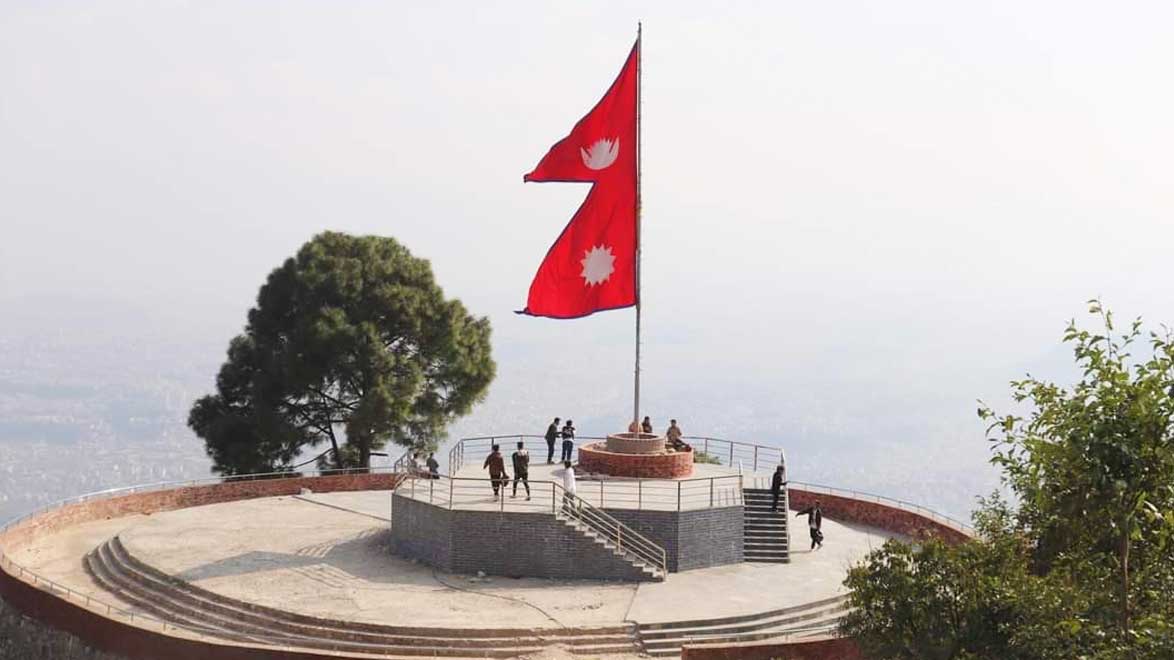 From this elevated position, visitors are treated to a stunning vista of rolling hills, lush valleys, and, weather permitting, the majestic Himalayan mountain range. This symbolic flag adds a touch of cultural significance to the panoramic experience. The serene ambiance of the park, combined with its strategic location, makes it a popular spot for locals and tourists alike to unwind and appreciate Nepal’s diverse topography.
From this elevated position, visitors are treated to a stunning vista of rolling hills, lush valleys, and, weather permitting, the majestic Himalayan mountain range. This symbolic flag adds a touch of cultural significance to the panoramic experience. The serene ambiance of the park, combined with its strategic location, makes it a popular spot for locals and tourists alike to unwind and appreciate Nepal’s diverse topography.